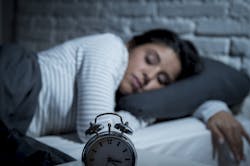An algorithm devised by researchers at the Massachusetts Institute of Technology can closely monitor sleeping patterns by analyzing radio waves reflected off the human body.
The software, described in a paper presented this week at the International Conference of Machine Learning, measures frequency changes that occur when radio waves emitted from specialized sensors reflect off a person’s body. That could let anyone analyze their sleep patterns at home without wearing smart wristbands and rings to bed.
“Our vision is developing health sensors that will disappear into the background and capture physiological signals and important health metrics,” said Dina Katabi, a professor of electrical engineering and computer science, who led the development of the home-router-sized sensors.
Katabi, who co-founded home monitoring start-up Emerald, and her colleagues have been coming up with new applications for the radio sensors, which can analyze pulse and breathing rate and detect emotion. The sensors can measure walking speed, which experts say could help predict cardiac and pulmonary diseases.
The new algorithm calculate body movements, pulse, and breathing patterns to determine if someone is lightly sleeping or showing symptoms of rapid eye movement, which indicates dreaming. The software filters out irrelevant information depending on the layout of your bedroom and how furniture is arranged.
These variables can change how radio waves scatter around a sleeping person, confusing traditional algorithms. But the researchers used machine learning to train their software to only take relevant information into account.
“Imagine if your Wi-Fi router knows when you are dreaming, and can monitor whether you are having enough deep sleep, which is necessary for memory consolidation,” Katabi said in a statement, referring to a process by which short-term memories are routed into the region of the brain that handle long-term storage.
These types of wireless sleep trackers are not exactly new, though. ResMed, which sells devices that help manage sleep apnea and other respiratory conditions, released a bedside device in 2014 that monitors sleepers by emitting radio waves to measure breathing and body movements.
The research team – which included Matt Bianchi chief of the sleep medicine division at Massachusetts General Hospital in Boston – says that their system is 80% accurate, similar to electroencephalography (EEG) machines in hospitals, which connect to patients via electrodes.
In addition to monitoring and tracking treatments for disorders like sleep apnea and insomnia, Katabi and her colleagues suggested that the technology could be used to study Parkinson’s, which is associated with complex sleep deficiencies, as well as other diseases like Alzheimer’s.
About the Author

James Morra
Senior Editor
James Morra is the senior editor for Electronic Design, covering the semiconductor industry and new technology trends, with a focus on power electronics and power management. He also reports on the business behind electrical engineering, including the electronics supply chain. He joined Electronic Design in 2015 and is based in Chicago, Illinois.
